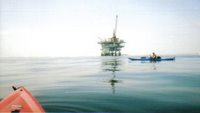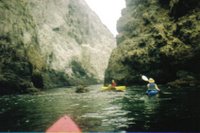Santa Cruz 2007


Big Difference #1: Less Birds. There are way less birds on Santa Cruz and, of course, no pungent bird poo smell (Some people call it AnaCRAPa). This also means less pesky birds trying to rip a hole in your tent and best of all, no waking up at 5am to a real life Alfred Hitchcock movie. Those of you that have been to Anacapa know what I mean. Big Difference #2: Campground and bathroom facilities. On Anacapa you get a relatively flat piece of dirt in the middle of a wind tunnel. On Santa Cruz you get a relatively flat piece of dirt, some shade, and less wind. Some of the guys that went with us this year even slept outside and one of them woke up with an island fox on his chest. They are all over the campground at night looking for an easy meal. Luckily they are about the size of a house cat and a meal is just the scraps that have been discarded by the
Big Difference #2: Campground and bathroom facilities. On Anacapa you get a relatively flat piece of dirt in the middle of a wind tunnel. On Santa Cruz you get a relatively flat piece of dirt, some shade, and less wind. Some of the guys that went with us this year even slept outside and one of them woke up with an island fox on his chest. They are all over the campground at night looking for an easy meal. Luckily they are about the size of a house cat and a meal is just the scraps that have been discarded by the 
 Big Difference #3: Hiking. On Anacapa (the east end that you camp on), I could run from one end of the island to the other in less than 10 minutes, and despite my appearance I am not a fast runner. On SantaCruz, I couldn’t walk the whole island in a day. Some of the guys we went with went on a 15 mile hike which took them past the highest point on our side of the island and they could see the ocean stretching out all around them. I heard it was pretty cool. I went on a couple of shorter hikes - Potato Harbor and Smugglers Cove. I highly recommend Potato Harbor if you like views from 100ft cliffs that lead straight into the crashing ocean. Smugglers Cove was also nice. It leads to a sandy beach with an olive grove growing on the hillside.
Big Difference #3: Hiking. On Anacapa (the east end that you camp on), I could run from one end of the island to the other in less than 10 minutes, and despite my appearance I am not a fast runner. On SantaCruz, I couldn’t walk the whole island in a day. Some of the guys we went with went on a 15 mile hike which took them past the highest point on our side of the island and they could see the ocean stretching out all around them. I heard it was pretty cool. I went on a couple of shorter hikes - Potato Harbor and Smugglers Cove. I highly recommend Potato Harbor if you like views from 100ft cliffs that lead straight into the crashing ocean. Smugglers Cove was also nice. It leads to a sandy beach with an olive grove growing on the hillside. Big Difference #4: Kayaking. Anacapa has great kayaking, but it was way easier to launch your boat and get a big group going from the beach at Santa Cruz compared to the dock at Anacapa. Also, some of the most awesome sea caves are within a 3 mile round trip. Anacapa has more sea caves and less tour guided mobs, but if you launch early in the morning, you probably won’t have a problem with the mobs. We didn’t make it out to Painted Cave (one of the biggest sea caves in the world), but it’s on my list of things to do before I die. If you have a boat and you want to take me there before I die, please respond.
Big Difference #4: Kayaking. Anacapa has great kayaking, but it was way easier to launch your boat and get a big group going from the beach at Santa Cruz compared to the dock at Anacapa. Also, some of the most awesome sea caves are within a 3 mile round trip. Anacapa has more sea caves and less tour guided mobs, but if you launch early in the morning, you probably won’t have a problem with the mobs. We didn’t make it out to Painted Cave (one of the biggest sea caves in the world), but it’s on my list of things to do before I die. If you have a boat and you want to take me there before I die, please respond.(Not So) Big Difference #5: Snorkeling. Anacapa has great snorkeling and so does Santa Cruz. I actually saw two bat rays this year while I was kayaking. One was nearly two-feet across.
Summary: It was a great trip that I hope I can continue doing throughout my life. Santa Cruz was much easier to visit than Anacapa. First of all, we took the boat instead of kayaking from the mainland. Second, the campground was more comfortable. Third, the activities were much more accessible. In general, it just took less effort to enjoy everything. I will always love Anacapa. I have many good memories from the two times I’ve been there, but I will probably stick to Santa Cruz and the other islands until one day when someone talks me into kayaking from the mainland again (Please don’t).
Most of these are from the Potato Harbor hike and our kayaking excursion, but there are a few other random shots mixed in. I think all of them enjoyed it, but Maddie loved it the most. You can see her flexing in one picture. According to her she has one girl arm and one man arm (muscular). See if you can tell which one is which.
And for all of you out there that think "Wow, that's cool but I could never do that." Just look at my mom and my sister (No offense Mom and Trish). They were very unsure of themselves, but as you can see the water in every picture is very calm. My mom liked it so much that she even went with Blake into some more sea caves.










Flipside Guy Photos
Here is a random sample of the guys who went. I didn't get pictures of everyone and being guys we didn't set up a group photo, so what you see is what you get. One side note about Jeff our Pastor in the blue kayak. He likes to make everything sound as terrifying as possible so
 don't let him scare you with his talk about giant swells smashing you into the ceiling of the sea cave. If an eight year old girl (Maddie) can do it, so can you.
don't let him scare you with his talk about giant swells smashing you into the ceiling of the sea cave. If an eight year old girl (Maddie) can do it, so can you. 









You'll notice that in the pictures of the island itself, the island looks pretty dry. This is because we always go in August when the ocean is calm. However, if you go in the spring, supposedly it is very green and beautiful with wildflowers and stuff. If you want to see pictures of the island in that stage, go to the Island Packers website: islandpackers.com
Sea Caves
This is what it's all about. The first two are of a rock formation called Scorpion Rock and the cave is called the Greenroom because on a sunny day the light from underwater holes turns it into an emerald green color. There is another cave we went in that was about 250ft deep, but none of the pictures turned out so well. I got to use my 1 million candle power spotlight in there. It was the highlight of the trip for me. At the back of the cave there is a small passage that leads into a large pool called Neptune's Caldron (I think). At first it didn't look safe to enter but then Rene went through without dying so I tried it. It was cool.




















